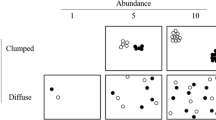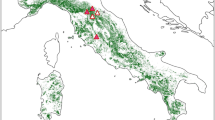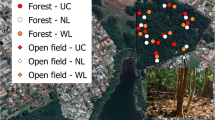Abstract
Estimating forest tree seeding before seedfall is important because annual fluctuations in seeding affect forest regeneration and wildlife behavior. Visual surveys for estimating tree seeding can be conducted easily, but cannot distinguish sound and unsound seeds, and cannot directly measure sound seedfall density, which closely correlates to seedling density and the food availability for wildlife. To establish an effective model for estimating sound seedfall density of Fagus crenata from a visual survey, seeding intensity at the tree level was visually rated into five classes in four stands for 7 years. Seedfall density of the visually surveyed trees was also measured by seed traps. Seeding intensity was strongly correlated with sound seedfall density at the tree level, and sound seedfall density differed among the five classes. However, a model that used only seeding intensity as an explanatory variable was not as effective at estimating sound seedfall density as more complex models that used the stand-level seeding index, calculated from the composition ratio of seeding intensity, in the current and previous years. More complex models improved the estimates because the proportion of sound-to-total seeds at the tree level depended on stand-level total seed production resulting from pollination efficiency and insect predator satiation. This method should be useful for forest management and wildlife conservation because it is rapid, easy, and highly accurate.


Similar content being viewed by others
References
Bates D, Maechler M, Bolker B (2012) lme4: linear mixed-effects models using S4 classes. R package version 0.999999-0. http://CRAN.R-project.org/package=lme4
Cecich RA, Sullivan NH (1999) Influence of weather at time of pollination on acorn production of Quercus alba and Quercus velutina. Can J For Res 29:1817–1823
Garrison BA, Wachs RL, Jones JS, Triggs ML (1998) Visual counts of acorns of California black oak (Quercus kelloggii) as an indicator of mast production. West J Appl For 13:27–31
Garshelis DL, Pelton MR (1981) Movements of black bears in the Great Smoky Mountains National Park. J Wildl Manag 45:912–925
Greenberg CH, Warburton GS (2007) A rapid hard-mast index from acorn presence–absence tallies. J Wildl Manag 71:1654–1661
Hashizume H, Fukutomi A (1978) Development and maturation of fruits and seeds in Fagus crenata. J Jpn For Soc 60:163–168 (in Japanese with English summary)
Hashizume H, Yamamoto S (1974a) Seed bearing of beech trees (Fagus crenata Blume) in the Chugoku district of Japan (I): a survey of fruit bearing. J Jpn For Soc 56:165–170 (in Japanese with English summary)
Hashizume H, Yamamoto S (1974b) Seed bearing of beech trees (Fagus crenata Blume) in the Chugoku district of Japan (II): the fertility and character of seeds. J Jpn For Soc 56:393–398 (in Japanese with English summary)
Hashizume H, Sugawara M, Nagae Y, Higuchi M (1984) Production and dispersal of reproductive organs in seed stands of Buna (Fagus crenata Blume) (I): production and dispersal of seeds. Bull Fac Agric Tottori Univ 36:35–42 (in Japanese with English summary)
Hiroki S, Matsubara T (1995) Fluctuation of nut production and seedling appearance of a Japanese beech (Fagus crenata Blume). Ecol Res 10:161–169
Hirota J, Kamitani T (1993) The density effect of mother trees on the fruit bearing and dispersal of the beech (Fagus crenata Blume) forests after selective cutting. J Jpn For Soc 75:313–320 (in Japanese with English summary)
Igarashi Y, Kamata N (1997) Insect predation and seasonal seedfall of the Japanese beech, Fagus crenata Blume, in northern Japan. J Appl Entomol 121:65–69
Jansen PA, Bongers F, Hemerik L (2004) Seed mass and mast seeding enhance dispersal by a neotropical scatter-hoarding rodent. Ecol Monogr 74:569–589
Kamitani T (1986) Studies on the process of formation of secondary beech forest in a heavy snowfall region (III): seed production in secondary beech forests with different diameter classes. J Jpn For Soc 68:447–453 (in Japanese with English summary)
Kelly D, Sork VL (2002) Mast seeding in perennial plants: why, how, where? Ann Rev Ecol Syst 33:427–447
Kikuchi S (1968) A research on the fruit-bearing of beech forests for the natural regeneration. Bull Yamagata Univ Agric Sci 5:221–306 (in Japanese with English summary)
Koenig WD, Knops JMH, Carmen WJ, Stanback MT, Mumme RL (1994) Estimating acorn crops using visual surveys. Can J For Res 24:2105–2112
Koike S, Kozakai C, Nemoto Y, Masaki T, Yamazaki K, Abe S, Nakajima A, Umemura Y, Kaji K (2012) Effect of hard mast production on foraging and sex-specific behavior of the Asiatic black bear (Ursus thibetanus). Mamm Study 37:21–28
Kon H, Noda T, Terazawa K, Koyama H, Yasaka M (2005a) Proximate factors causing mast seeding in Fagus crenata: the effects of resource level and weather cues. Can J Bot 83:1402–1409
Kon H, Noda T, Terazawa K, Koyama H, Yasaka M (2005b) Evolutionary advantages of mast seeding in Fagus crenata. J Ecol 93:1148–1155
Koyama H, Yasaka M, Terazawa K, Kon H (2000) The effect of site preparation timing on regeneration success of beech (Fagus crenata Blume): a demonstration of practical use value of seed crop prediction method. J Jpn For Soc 82:39–43 (in Japanese with English summary)
Koyama H, Yasaka M, Terazawa K, Kon H (2007) Forecasting a poor crop in two years later of beech (Fagus crenata) stand by winter bud investigation. Jpn J For Environ 49:35–40 (in Japanese with English summary)
Kozakai C, Yamazaki K, Nemoto Y, Nakajima A, Koike S, Abe S, Masaki T, Kaji K (2011) Effect of mast production on home range use of Japanese black bears. J Wildl Manag 75:867–875
Landis JR, Koch GG (1977) The measurement of observer agreement for categorical data. Biometrics 33:159–174
Masaka K, Sato H (2002) Acorn production by Kashiwa oak in a coastal forest under fluctuating weather conditions. Can J For Res 32:9–15
Masaki T, Abe S (2008) A test of visual assessment of crop size of Quercus crispula using a binocular. J Jpn For Soc 90:241–246 (in Japanese with English summary)
Masaki T, Oka T, Osumi K, Suzuki W (2008) Geographical variation in climatic cues for mast seeding of Fagus crenata. Popul Ecol 50:357–366
McDonald PM (1992) Estimating seed crops of conifer and hardwood species. Can J For Res 22:832–838
Miguchi H, Maruyama K (1984) Ecological studies on a natural beech forest (XXXVI): development and dynamics of beechnuts in a mast year. J Jpn For Soc 66:320–327 (in Japanese with English summary)
Mizoue N, Dobbertin M (2003) Detecting differences in crown transparency assessments between countries using the image analysis system CROCO. Environ Monit Assess 89:179–195
Mizui N (1991) Classification of seed production based on the correlation between seed-weight and seed-number in deciduous broadleaved tree species. J Jpn For Soc 73:258–263 (in Japanese with English summary)
Mizutani M, Nakajima H, Kodani J, Nogami T, Tada M (2013) Relationship between the acorn crops of Fagaceae trees and the mass intrusions of bears into residential areas in the Hokuriku region. J Jpn For Soc 95:76–82 (in Japanese with English summary)
Myers RH (1990) Classical and modern regression with applications, 2nd edn. PWS-KENT, Boston
Nakajima H (2009) Maturity process of oak acorns in Toyama prefecture: suitable period for visual assessment of crop size to predict mass appearance of Asiatic black bears. Bull Toyama For Res Inst 1:16–22 (in Japanese with English summary)
Nakajima H (2013) Estimation of beech (Fagus crenata) seed crops from female inflorescence scars: relationship between seed crops and degree of intrusion into residential areas by Asiatic black bears in Toyama Prefecture, Japan. J Jpn For Soc 95:71–75 (in Japanese with English summary)
Nakajima H, Kodani J (2013) Prediction of beech (Fagus crenata) seeding based on fallen male inflorescences number in Hokuriku district, Japan: the difference in proportion of filled seeds between disjunct populations and continuously distributed populations. J Jpn For Soc 95:51–59 (in Japanese with English summary)
Nakajima H, Kume A, Ishida M, Ohmiya T, Mizoue N (2011) Evaluation of estimates of crown condition in forest monitoring: comparison between visual estimation and automated crown image analysis. Ann For Sci 68:1333–1340
Oka T, Miura S, Masaki T, Suzuki W, Osumi K, Saitoh S (2004) Relationship between changes in beechnut production and Asiatic black bears in northern Japan. J Wildl Manag 68:979–986
Perry RW, Thill RE (1999) Estimating mast production: an evaluation of visual surveys and comparison with seed traps using white oaks. South J Appl For 23:164–169
R Core Team (2012) R: a language and environment for statistical computing. R Foundation for Statistical Computing, Vienna, Austria. ISBN 3-900051-07-0. http://www.R-project.org/
Saito H, Imai H, Takeoka M (1991) Peculiarities of sexual reproduction in Fagus crenata forests in relation to annual production of reproductive organs. Ecol Res 6:277–290
Sawada H, Kaji M, Oomura K, Igarashi Y (2008) Influences of mast seeding on tree growth dynamics of Fagus crenata and Fagus japonica in central Honsyu, Japan. J Jpn For Soc 90:129–136 (in Japanese with English summary)
Sugita H, Takahashi M, Shimatani K (2009) Importance of advanced regeneration in natural regeneration practices of Fagus crenata at the Hakkoda Research Site, northern Honshu, Japan. J Jpn For Soc 91:382–390 (in Japanese with English summary)
Suzuki W, Osumi K, Masaki T (2005) Mast seeding and its spatial scale in Fagus crenata in northern Japan. For Ecol Manag 205:105–116
Takeda H (1992) Fruiting valuations of beech (Fagus crenata Blume) trees at Nonomi beech forest for seven years. J Jpn For Soc 74:55–59 (in Japanese with English summary)
Terazawa K, Yanai S, Yasaka M (1995) Characteristics of seed production of Fagus crenata (I): quantity and quality of fallen nuts in natural stands in southwestern Hokkaido from 1990 to 1993. J Jpn For Soc 77:137–144 (in Japanese with English summary)
Whitehead CJ (1969) Oak mast yields on wildlife management areas in Tennessee. Tennessee Game and Fish Commission, Nashville
Yasaka M, Koyama H, Terazawa K, Kon H (2001) A prediction method for beech (Fagus crenata) mast based on winter bud investigation. J Jpn For Soc 83:322–327 (in Japanese with English summary)
Yasaka M, Terazawa K, Koyama H, Kon H (2003) Masting behavior of Fagus crenata in northern Japan: spatial synchrony and pre-dispersal seed predation. For Ecol Manag 184:277–284
Acknowledgments
I thank the anonymous referees and editor for their valuable comments. I am grateful to Toyama District Forest Office and Nanto City for permission to use the stands, to my colleagues at Toyama Prefectural Government for their helpful support, and to Yukimi Kayamori and Natsuko Aoki for their assistance with counting seeds in the laboratory. This study was funded by Toyama Prefecture, Japan.
Author information
Authors and Affiliations
Corresponding author
About this article
Cite this article
Nakajima, H. Estimating sound seedfall density of Fagus crenata using a visual survey. J For Res 20, 94–103 (2015). https://doi.org/10.1007/s10310-014-0440-7
Received:
Accepted:
Published:
Issue Date:
DOI: https://doi.org/10.1007/s10310-014-0440-7




